A toilet is a complex plumbing product consisting of several elements. Each performs a specific function and has its own parameters. However, for most consumers, three values matter: height, width and depth.
What sizes are there?
The content of the article
- What sizes are there?
- Are there standards?
- What does size affect?
-
Popular types of toilets and their dimensions
- Compact
- Suspended with installation
- Attached (wall-mounted)
- Corner
- Monoliths
- Without cistern
- How to calculate the required parameters?
- What toilet accessories are needed?
- Flush tank parameters
- Toilet bowl installation tips
By size, the toilet bowls can be conditionally divided into two categories - for adults and for children. The former are used everywhere: in residential buildings, state, municipal and private institutions. The second - smaller - are installed mainly in children's organizations (kindergartens, hospitals, etc.). They are also purchased by the owners of cottages equipped with several bathrooms, including those specially for children.
Are there standards?
Toilet bowls made of sanitary ware and sanitary porcelain are not subject to mandatory certification, but standards exist. The last GOST for them was adopted in 2017 and takes into account the peculiarities of modern communications, building codes, as well as consumer requests.
In accordance with its requirements, models are distinguished by the type of attachment:
- outdoor, including for children;
- wall.
According to this standard, floor-standing toilets must be manufactured with a solid shelf, funnel bowl, horizontal, oblique (45˚) or vertical outlet.
Standard dimensions height × length × width (in cm):
- children - 33.5 × 40.5 × 29;
- adult - 40 × 60.5 × 34 and 36.
It is allowed to manufacture wall-mounted and attached toilets with a wall-mounted or one-piece cast (monolith) cistern.
Standard sizes:
- wall models - 35 × 45 × 60 × 340 and 360;
- copies without one-piece shelf - 40 × 46 × 36 cm.
Much less often, but still on sale there are also dish-shaped and visor toilets, as well as toilets with a hanging cistern. In Russian apartments and institutions, there are still similar modifications provided for by the domestic GOSTs of 1985 and 1996.
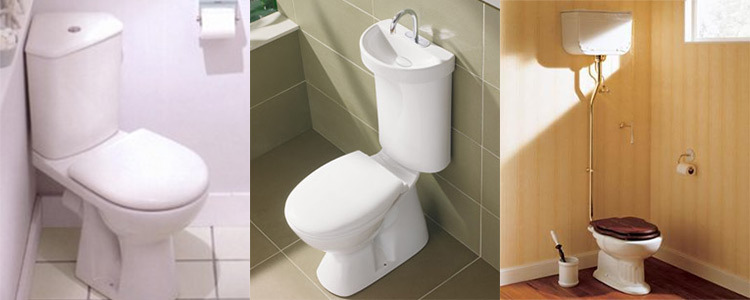
What does size affect?
Each item is made in such a shape and size that provide its ideal functionality. Adults and children have different heights and weights, therefore the dimensions of the toilet seat for large and small differ.
The height of the toilet is designed for an average person's height and reaches approximately to his knee. The user, sitting on it, should not experience discomfort, and for this, the legs should not hang down, but stand firmly on the floor so that tension does not arise in them.
The width and depth of the seat should also ensure that the gluteal part of the body is attached to it. Optimal bowl parameters do not allow either "dips" inward, or "overhangs" outward.
The most variable value - depth (or length) - fluctuates depending on the presence or absence of a cistern on the body, as well as on its size.
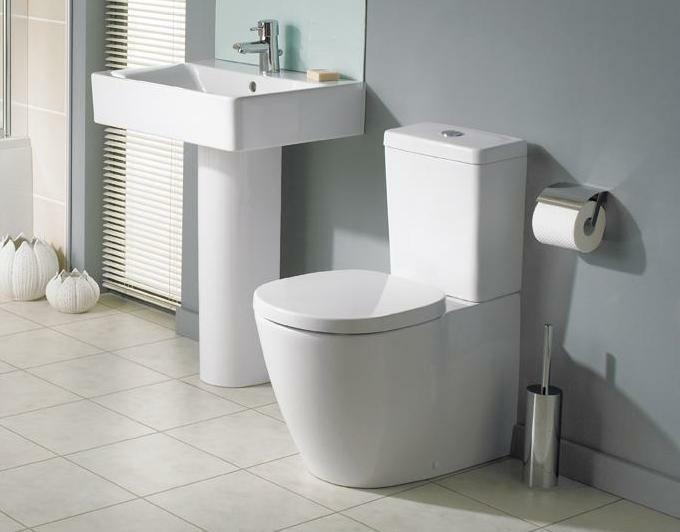
Popular types of toilets and their dimensions
Plumbing companies produce models that differ in appearance, installation location, fastening methods and types of connection of elements. Their sizes are close to the standards, small deviations are allowed.
Compact
The classic version of the floor-standing toilet is one-piece design, including a bowl with a foot and a shelf with a cistern. For different manufacturers, the seat height of the "adult" model is from 39 to 41 cm, the length of the bowl to the lid mounts is from 42 to 49 cm, and the width is from 34 to 37 cm. Water supply is provided from below or from the side. They are fastened to the floor with anchor bolts, therefore, theoretically, it can be installed at any distance from the wall, if there is a sewer supply and cold water pipes. This is the most common, budgetary and affordable option for self-assembly.
Suspended with installation
Relatively "young" type. It is mounted on a metal frame, attached to the main wall and floor with anchor bolts, withstanding a weight from 250 kg to half a ton. In the same place, inside the installation, the cistern is also hidden. The surface is covered, only the flush plates are brought out. Does not connect to the floor, so it does not complicate cleaning and visually takes up less space than the floor one. Most installations are height adjustable so that a family of basketball players can set it slightly higher without any problem. The sizes fit into the standard ones.
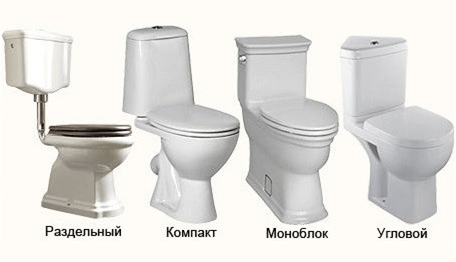
Attached (wall-mounted)
They stand on the floor, the rear vertical surface fits snugly against the wall, all communications and fixtures are hidden behind the glossy surface of a faience or porcelain pedestal. Can be with a cistern:
- on the shelf;
- hidden in the false wall.
The joints with the wall and floor are coated with sealant. The dimensions correspond approximately to GOST.
Corner
A variation of the previous model, but the rear part, including the tank, is "sharpened" at an angle. Such designs have gained popularity in the current century. Cabinets, kitchen corners, and now corner toilets save usable space without creating the impression of being cramped. When installing the toilet in the corner, it is convenient to use it: you cannot touch anything on the right or left, because the space expands from the corner.
Monoliths
Toilet bowls in which both the bowl and the tank are a single whole. They are cast entirely, they look aesthetically pleasing, but in the event of a tank breakdown, repairs will be impossible. In addition, their weight reaches 500 kg, which creates additional difficulties during transportation and installation.
Without cistern
Such designs, providing for direct connection to the drain, are widespread in Germany. They save resources, but they do not wash well at low pressure in the cold water supply pipe.
How to calculate the required parameters?
If you have made repairs and decided to replace the plumbing, then before buying a toilet of a certain type, consider the basic rules for placing it in a toilet or a combined bathroom. For a comfortable visit to the toilet, you must:
-
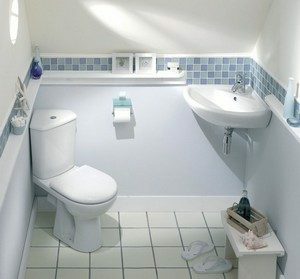 measure the area of free space within which you are going to position the toilet. The distance in front of the unit should be 60 cm or more, on the sides - at least 40 cm from the central axis of the bowl (from the edges - about 22 cm);
measure the area of free space within which you are going to position the toilet. The distance in front of the unit should be 60 cm or more, on the sides - at least 40 cm from the central axis of the bowl (from the edges - about 22 cm); - take into account the volume of the largest family member;
- familiarize yourself with the basic parameters of commercially available toilets and choose a suitable model.
For example, to install a compact toilet bowl 40 × 60 × 36, you will need free space in the shape of a rectangle with sides of 120 and 80 cm. If there is less space, you should take a closer look at a smaller model or an option with a hanging tank..
Suspended or wall-mounted copies will require as much space as compact ones, but visually, due to the communications hidden in the false wall and the tank, there will be a space saving effect.
The square meter by meter is ideal for installing the corner model 75 cm long and 36 cm wide.
What toilet accessories are needed?
By the way! If you purchased only a toilet bowl, you will have to buy the rest of the construction elements: a cistern, installation, fasteners, lid. If you spent money on a turnkey kit, you won't have to do this.
After the new toilet has moved from the store to your apartment and has taken its place in the bathroom, it must be surrounded with little things that will be needed by users. These include:
- toilet paper holder;
- a brush in a special stand;
- shelf for detergents and cleaning products.
All of these accessories should be within walking distance so that they can be easily used at the right time.
Flush tank parameters
In compact and monolithic models, the cistern is “attached” to the toilet. In other cases, it is possible to choose it separately, giving preference to the desired company and model. By purchasing it, it is necessary to take into account compatibility with the bowl, methods of water supply and connection to the sewer.
The approximate dimensions of the cistern for various types of toilet bowl:
- compact: width - from 16 to 18 cm, length - from 35 to 37 cm, height - from 37 to 40 cm;
- suspended (with installation): 14-23 × 29, 5-41 × 36-48 cm;
- angular (conventionally triangular): sides - 30 × 30 × 43 cm, height - about 40 cm;
- medium and high hanging cisterns: 13 × 40 × 35 cm.
Toilet bowl installation tips
-
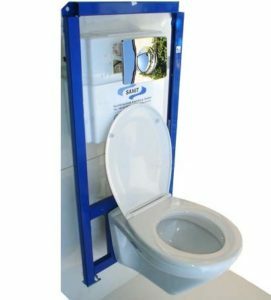 When making a purchase, check the availability of all the necessary spare parts, and if necessary, buy the missing ones.
When making a purchase, check the availability of all the necessary spare parts, and if necessary, buy the missing ones. - A floor-standing toilet can be installed by yourself, strictly following the instructions. It is better to entrust the installation of the suspended one to specialists.
- Provide free access to the product already at the installation stage.
- Place the structure on a flat floor. Small irregularities can be corrected with silicone sealant.
- When installing wall-mounted models, the technical holes in the wall and plumbing must match perfectly, so follow the rule: "Measure seven times - cut once."
- If necessary, use flexible hoses and corrugations.
- The height of the seat from the floor should be comfortable and at least roughly meet the standards.
Sequence of actions when installing a floor-standing toilet:
- assembly of the tank (if necessary);
- sewerage installation;
- "Fitting" the toilet in place;
- marking and drilling of mounting holes;
- installation of the product (and the tank);
- connection of a cold water supply pipe.
If the model is wall-mounted, you need to start by installing a hidden mount.
The order of manipulations when installing a wall-mounted toilet with installation:
- markup;
- fastening the support frame to the floor and wall;
- adjustment of holes for attaching the toilet to the required height;
- connecting the tank to the water supply system;
- fixing the toilet to the fittings, connecting to the sewer hole;
- external lining, taking into account the drain holes and release buttons on the tank;
- installation of accessories.
Thanks to the rapidly developing innovative technologies, new, more convenient and functional models of plumbing, including those with electronic control, appear. However each is still manufactured in accordance with design drawings, quality and safety requirements. And since the growth and dimensions of the average person change insignificantly over the years, the approximate height of the toilet bowl from the floor, as well as the main dimensions of the bowl, remain the same as half a century ago.
Subscribe to our Social Networks


